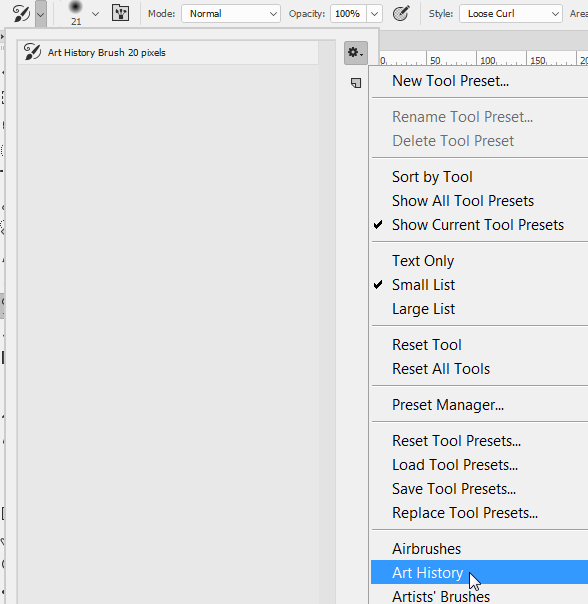 Adobe Community
Adobe Community
- Home
- Photoshop ecosystem
- Discussions
- Re: Mysteries of the Art History Brush "Style"
- Re: Mysteries of the Art History Brush "Style"
Mysteries of the Art History Brush "Style"
Copy link to clipboard
Copied
I have spent many hours trying to work out what combination of elements gives useful painting brushes with the Art History brush tool. I have some favourites that I use, and am constantly trying new combinations of brush tip (including particularly my own custom ones) style, resolution, size, area, tolerance and document resolution, but I cannot find any predictable relationships. For example, why do some, in fact many, combinations produce spidery line coverage or mottling rather than broad brushstrokes? Can anyone point me to an explanation or description of how specific styles react to different types of brush and paper resolution? Is there any guidance on what types of brush tip and brush size play well with different styles?
The standard advice given to questions about using the AHB is to experiment. I have experimented a great deal. Experimentation, if it does not produce some predictable results, is frustrating.
Can anyone point me at any detailed guidance about the AHB, please? I have Googled but this did not produce the information I am after. Thanks.
David
Explore related tutorials & articles
Copy link to clipboard
Copied
The AHB samples from the history state that the source is next to in the History panel. Perhaps you already know this.
You could start by choosing one of the presets. They need to be loaded. Select Art History from the list.

A smaller brush size will result in more detail, which most people find more desirable.
A good tip is to paint on a new blank layer so that you can more easily make changes. A separate layer also gives you the option to add a layer mask and change the layer opacity.
The AHB is somewhat random by nature, which is probably why you see the advise to experiment.
Copy link to clipboard
Copied
Thanks. I would (modestly) say that I am an advanced user of the AHB and have made many pictures with it. I was after some technical explanation of the relationships to make brush creation more predictable. You may have answered my question by saying that the AHB is somewhat random by nature, but I would love to know from the AHB original creator if there are any rules to how the various features work together by design. I may say I love the AHB and enjoy using it.
Copy link to clipboard
Copied
I've not seen a technical explanation of the AHB. You may have already seen Adobe's Julianne Kost tutorial History and Art History Brush « Julieanne Kost's Blog
If you contact her perhaps she can shed some light on the technical aspects or know who can. jkost@adobe.com
Copy link to clipboard
Copied
Thanks, Barbara. I hadn't seen the blog and will read it.
David
